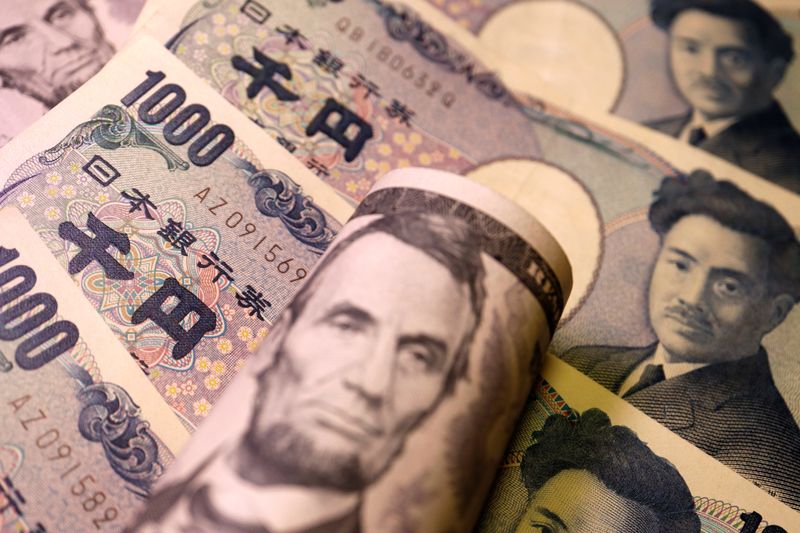Forex
Dollar steady before Fed minutes; yen hovers below 145-mark


© Reuters. Japanese yen and U.S. dollar banknotes are seen in this illustration picture taken June 15, 2022. REUTERS/Florence Lo/Illustration
By Herbert Lash
NEW YORK (Reuters) – The U.S. dollar held steady against other major currencies on Wednesday as traders awaited minutes later in the session from the Federal Reserve’s last policy meeting to glean any potential insights on the outlook for interest rates.
The – which measures the greenback against a basket of six other currencies, including the euro and Japan’s yen – was basically flat on the day at 103.07, having held in a range of roughly 102.75-103.75 since early June.
The Federal Open Market Committee is due to release the minutes from its most recent policy meeting at 1400 EDT (1800 GMT).
Markets are pricing in an 85.2% chance that the Fed will raise rates by another quarter-point in July but have not warmed to the Fed’s message that there could be another hike later this year.
“We’ll have to see if the minutes play up to how the Fed has really driven home a hawkish message where they’re not done raising rates yet to bring down inflation,” said Joe Manimbo, senior market analyst at Convera in Washington.
“Of course, another barometer for what the Fed does will be the jobs report on Friday,” he said.
The non-farm payrolls report on Friday is expected to show the U.S. economy will have added 225,000 jobs in June, and that the unemployment rate edged down to 3.6% last month, according to a Reuters poll.
“The economy looks resilient overall, but manufacturing has been in this funk for eight months and counting and we’ll have to see if that leads the Fed to signal that it’s not far from the end of its tightening cycle,” Manimbo said.
The euro rose 0.2% at $1.090, while sterling was up 0.1% at $1.2729.
The dollar hovered around 144.165 yen, below the 145 threshold that prompted intervention by Japanese authorities last autumn. The greenback had last week briefly popped as high as 145.07 for the first time since November.
INTERVENTION RISK?
The dollar-yen rate has broadly moved in sync with the , which was roughly unchanged on the day at 3.868% after resuming trade following the U.S. Independence Day holiday on Tuesday.
“The market is paying attention to the potential risk of intervention, but as a medium-term trend, the market is looking for further downside for the yen,” said Shusuke Yamada, chief forex and rates strategist at Bank of America (NYSE:) in Tokyo.
“We don’t see a very high probability that the Ministry of Finance will intervene at the same level as last year – and if the move is not rapid, below 150 we might not see intervention at all.”
Australia’s dollar fell in line with the after data showed China’s services activity expanded at the slowest pace for five months in June, the latest sign of a sputtering post-pandemic recovery in the world’s second-largest economy.
The Australian dollar fell 0.1% to $0.6683, on course to snap a four-day streak of gains.
Prior to the Chinese services data, the had been slightly firmer following another stronger yuan fixing from the People’s Bank of China, fueling bets for imminent policy support from Beijing.
The yuan rebounded a touch, up 0.2% at 7.2509.
Currency bid prices at 9:34AM (1334 GMT)
Description RIC Last U.S. Close Pct Change YTD Pct High Bid Low Bid
Previous Change
Session
Dollar index 102.9500 103.0700 -0.10% -0.522% +103.2100 +102.9500
Euro/Dollar $1.0899 $1.0877 +0.20% +1.71% +$1.0908 +$1.0868
Dollar/Yen 144.1650 144.4800 -0.21% +9.96% +144.7250 +144.1450
Euro/Yen 157.11 157.16 -0.03% +11.98% +157.7200 +156.8000
Dollar/Swiss 0.8963 0.8975 -0.09% -3.03% +0.8994 +0.8963
Sterling/Dollar $1.2729 $1.2714 +0.11% +5.25% +$1.2735 +$1.2689
Dollar/Canadian 1.3249 1.3220 +0.23% -2.20% +1.3293 +1.3221
Aussie/Dollar $0.6683 $0.6692 -0.14% -1.97% +$0.6698 +$0.6657
Euro/Swiss 0.9766 0.9758 +0.08% -1.30% +0.9789 +0.9759
Euro/Sterling 0.8560 0.8555 +0.06% -3.21% +0.8575 +0.8555
NZ $0.6204 $0.6192 +0.19% -2.29% +$0.6206 +$0.6180
Dollar/Dollar
Dollar/Norway 10.6440 10.6440 +0.06% +8.52% +10.7090 +10.6190
Euro/Norway 11.6023 11.5939 +0.07% +10.56% +11.6586 +11.5635
Dollar/Sweden 10.8496 10.8117 +0.39% +4.25% +10.8777 +10.8165
Euro/Sweden 11.8212 11.7754 +0.39% +6.02% +11.8361 +11.7767

 Forex3 years ago
Forex3 years agoForex Today: the dollar is gaining strength amid gloomy sentiment at the start of the Fed’s week

 Forex3 years ago
Forex3 years agoUnbiased review of Pocket Option broker

 Forex3 years ago
Forex3 years agoDollar to pound sterling exchange rate today: Pound plummeted to its lowest since 1985

 Forex3 years ago
Forex3 years agoHow is the Australian dollar doing today?

 Cryptocurrency3 years ago
Cryptocurrency3 years agoWhat happened in the crypto market – current events today

 World3 years ago
World3 years agoWhy are modern video games an art form?

 Commodities3 years ago
Commodities3 years agoCopper continues to fall in price on expectations of lower demand in China

 Economy3 years ago
Economy3 years agoCrude oil tankers double in price due to EU anti-Russian sanctions





















